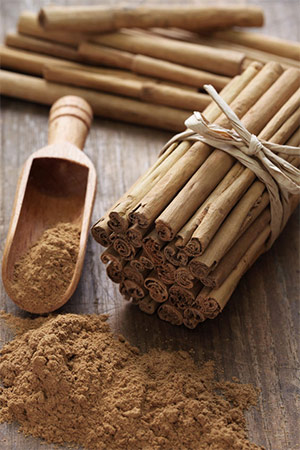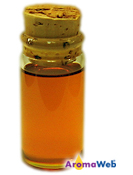Cinnamon Essential Oil
Cinnamomum verum / Cinnamomum zeylanicum

Description
Cinnamon Bark Essential Oil is steam distilled from the bark of the cinnamon tree. Cinnamon Bark Essential Oil is generally preferred over Cinnamon Leaf Essential Oil. However, oil distilled from cinnamon bark tends to be much more costly than that distilled from the leaves of the tree.
Aromatically, Cinnamon Bark Essential Oil is much more intense in aroma than ground cinnamon. Cinnamon Bark Oil tends to be warming, stimulating and energizing.
Both Cinnamon Bark Essential Oil and Cinnamon Leaf Essential Oil blend well with many other essential oils especially essential oils in the wood, spice, citrus and mint families.

It is my understanding that most of the "Ground Cinnamon" that we purchase in grocery stores, and even most of the "Cinnamon Sticks" that are sold are not true cinnamon, but are really its more affordable cousin, Cassia, Cinnamomum cassia.
Topically, both Cinnamon Bark Essential Oil and Cinnamon Leaf Essential Oil should be used with extreme caution, if at all. The dermal maximum for Cinnamon Bark Essential Oil is even less than for Cinnamon Leaf Essential Oil. Refer to the Safety Information section below for more information.
Cinnamon Bark Essential Oil Benefits and Uses
- Sluggish Digestion
- Colds/Flu Exhaustion
- Lice
- Circulation
- Rheumatism
- Scabies
- Stress
Source: Julia Lawless, The Encyclopedia of Essential Oils (Updated Edition) (London: Harper Thorsons, 2014), 74-75.
Botanical Name
Cinnamomum verum / Cinnamomum zeylanicum
Plant Family
Common Method of Extraction
Steam Distilled
Plant Part Typically Used
Color
Golden Yellow/Brown
Consistency
Slightly oily feeling
Perfumery Note
Middle
Strength of Initial Aroma
Strong
Aromatic Description
Cinnamon Bark Essential Oil smells peppery, earthy, spicy, bright yet slightly woodsy.
Bark Oil Major Constituents
- (E)-Cinnamaldehyde
- Eugenol
- (E)-Cinnamyl Acetate
- Linalool
- B-Caryophyllene
- p-Cymene
See Essential Oil Safety for a more complete list of typical constituents.
Source: B.M. Lawrence, Essential Oils 1988-1991 (Wheaton: Allured Publishing, 1995), 201. F. Tateo, F. Chizzini, The Composition and Quality of Supercritical CO2 Extracted Cinnamon. (Journal of Essential Oil Research 1, 1989), 165-168. K.H. Kubeczka, Essential Oils Analysis by Capillary Gas Chromatography and Carbon-13 NMR Spectoroscopy, Second Edition. (Chichester: Wiley, 2002). Sources cited in Robert Tisserand and Rodney Young, Essential Oil Safety (Second Edition. United Kingdom: Churchill Livingstone Elsevier, 2014), 248-249.
Leaf Oil Major Constituents
Eugenol
Eugenyl acetate
Linalool
(E)-Cinnamyl acetate
Benzyl benzoate
See Essential Oil Safety for a more complete list of constituents.
[B.M. Lawrence, Essential Oils 1976-1978 (Wheaton: Allured Publishing, 1979), 29. B.M. Lawrence, Essential Oils 1988-1991 (Wheaton: Allured Publishing, 1995), 148, 201. Sources cited in Robert Tisserand and Rodney Young, Essential Oil Safety (Second Edition. United Kingdom: Churchill Livingstone Elsevier, 2014), 248-249.]
Cinnamon Essential Oil Safety Information
Tisserand and Young indicate that both the bark and the leaf oil are low risk for mucous membrane irritation, may inhibit blood clotting and pose a drug interaction hazard. Cinnamon Bark Oil may cause embryotoxicity and is contraindicated in pregnancy and breastfeeding. There is a high risk of skin sensitization with the bark oil, and Tisserand and Young recommend a dermal maximum of 0.07% for the bark oil. For the leaf oil, Tisserand and Young recommend a dermal maximum of 0.6%. Reading Tisserand and Young's full profile for both the bark and leaf oils is recommended. [Robert Tisserand and Rodney Young, Essential Oil Safety (Second Edition. United Kingdom: Churchill Livingstone Elsevier, 2014), 248-250.]
This essential oil poses a higher risk of causing irritation and sensitization when used in the bath. Avoid using it in the bath, even if it is solubilized/diluted.
Cinnamon Bark CO2 Supercritical Total Extract (Cinnamomum burmannii)
In addition to being available as an essential oil, this botanical is available from a small number of reputable sources as a CO2 extract. CO2 extracts offer many advantages. However, they can have differing safety precautions than essential oils because the natural chemistry of CO2 extracts can differ from their essential oil counterparts. Not much safety information is documented from trusted sources for CO2 extracts. Use CO2 extracts with great care and do not assume that every CO2 extract has the same safety precautions as its essential oil counterpart.
General Safety Information
Do not take any oils internally and do not apply undiluted essential oils, absolutes, CO2s or other concentrated essences onto the skin without advanced essential oil knowledge or consultation from a qualified aromatherapy practitioner. For general dilution information, read AromaWeb's Guide to Diluting Essential Oils. If you are pregnant, epileptic, have liver damage, have cancer, or have any other medical problem, use oils only under the proper guidance of a qualified aromatherapy practitioner. Use extreme caution when using oils with children and be sure to first read the recommended dilution ratios for children. Consult a qualified aromatherapy practitioner before using oils with children, the elderly, if you have medical issues or are taking medications. Before using this or any essential oil, carefully read AromaWeb's Essential Oil Safety Information page. For in-depth information on oil safety issues, read Essential Oil Safety by Robert Tisserand and Rodney Young.
Shelf Life
Important Information About the Profiles
The essential oil information provided on AromaWeb is intended for basic educational purposes only. The references to safety information, test results, constituents and percentages is generalized information. Essential oils can vary greatly in composition. The data is not necessary complete and is not guaranteed to be accurate. The essential oil photos are intended to represent the typical and approximate color of each essential oil. However, essential oil composition and color can vary based on harvesting, distillation, age of the essential oil and other factors. Profiles for several CO2 Extracts and absolutes are included within the directory, and are denoted as such.
